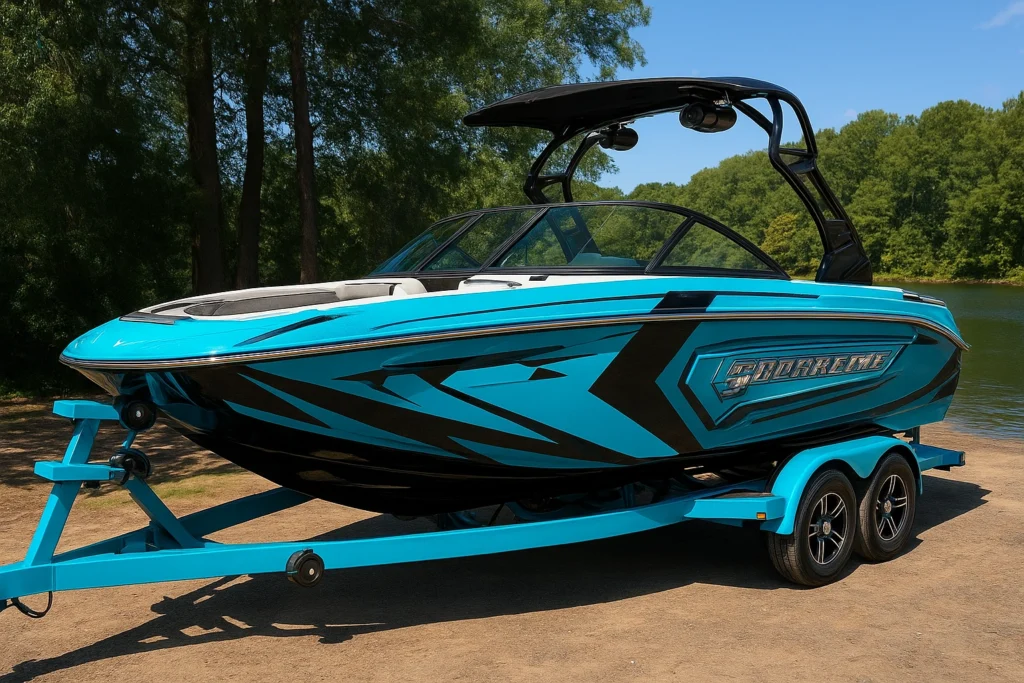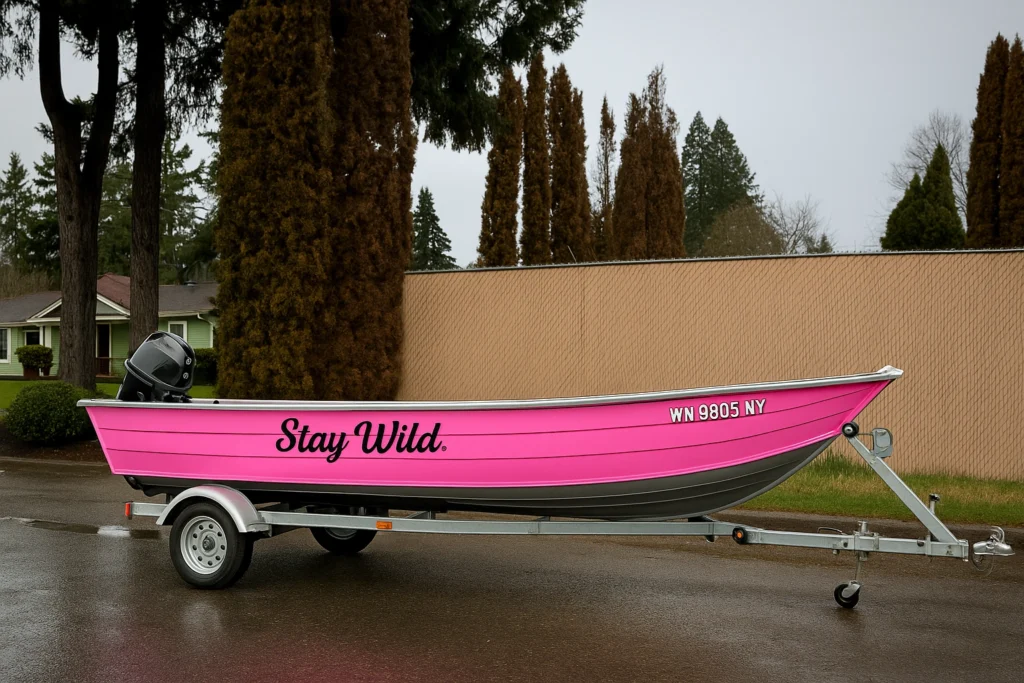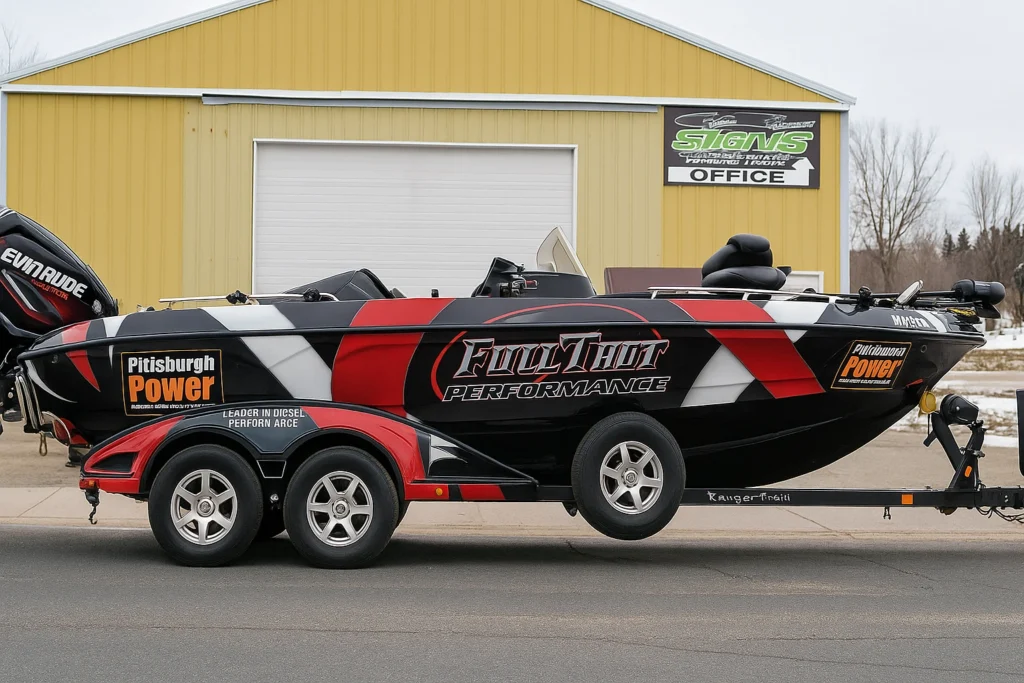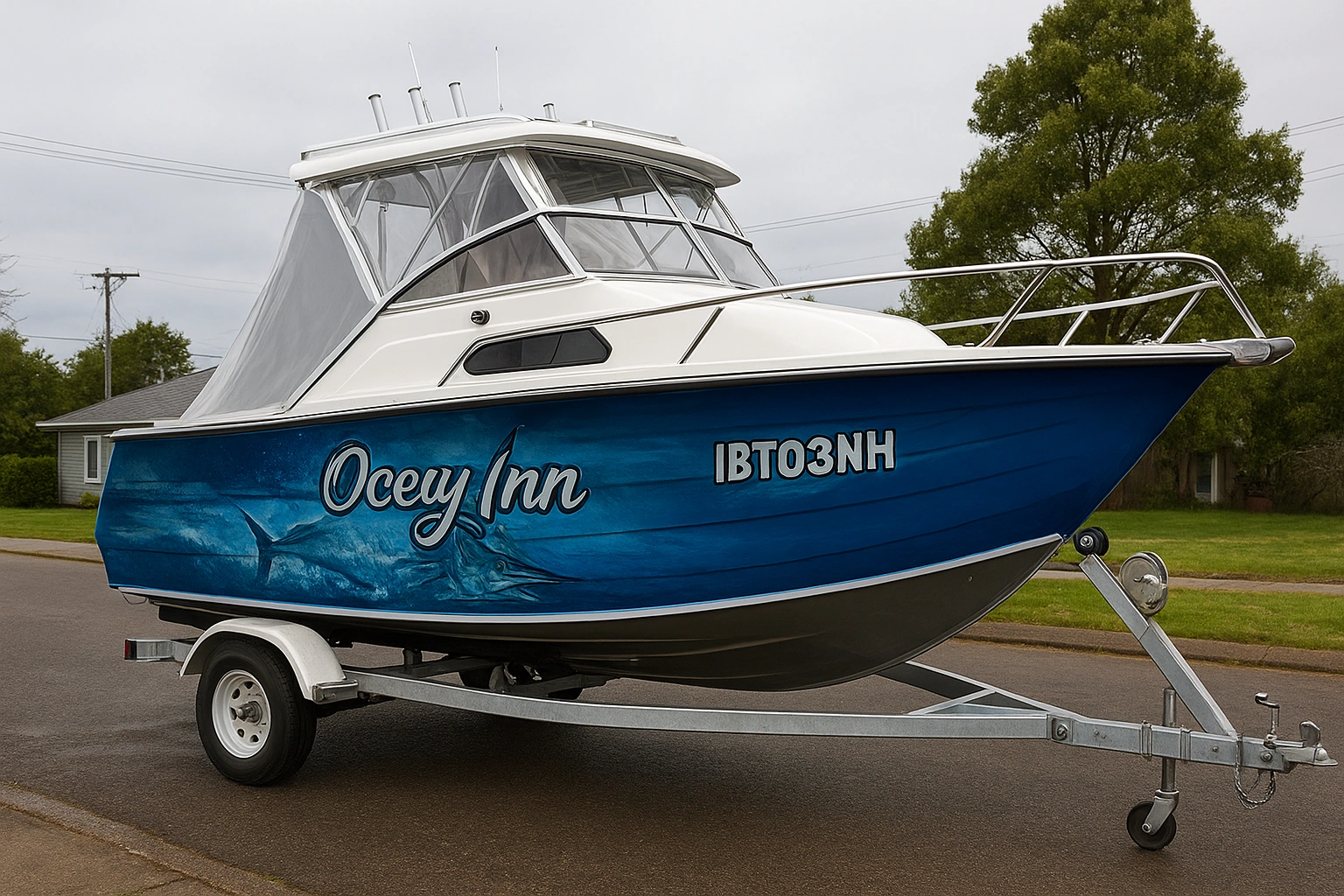Introduction
If you own a boat and spend time on saltwater, you know the challenges: sun-bleached gelcoat, corrosion from salt spray, and the constant need to maintain that showroom finish. That’s why I’m writing this guide on boat & marine vinyl wraps (saltwater care).
At Vinyl Wrap Pro, I’ve overseen dozens of marine wrap jobs, ranging from center consoles in Florida to charter yachts in California. I’ve seen what works, what fails, and the secrets that separate a wrap that lasts 7 years vs one that peels in 18 months. In this post, we’ll dig into materials, installation best practices, maintenance strategies, cost vs paint comparisons, and real-world case studies so you can make informed decisions and protect your investment at sea.
Key Takeaways
- Marine-grade vinyl wraps can protect your boat’s finish, resist UV and saltwater damage, and allow custom graphics at lower cost than paint.
- Quality materials + expert surface prep + seasoned installers = critical triple-factor for success.
- In saltwater environments, maintenance matters: rinse after every outing, wash with mild soap, inspect seams/edges monthly.
- A high-quality wrap properly maintained can last 5-7 years; paint may last longer but costs more and takes longer downtime.
- Choose finishes and colors smartly (lighter colors reflect heat, darker may absorb it) and look beyond aesthetics toward durability.
- Use internal resources like our “truck & fleet wraps” page for commercial operators and “atv & utv wraps durability off road” for off-water craft.
- Check warranty terms: see our “Vinyl Wrap Warranty & Guarantees (What’s Covered)” page for what matters.

Why Boat & Marine Vinyl Wraps Matter in Saltwater Environments
Saltwater is far more aggressive than freshwater. It brings UV, corrosion, barnacle draw, airborne salt crystals, and high-intensity sun. On top of that, boats often have curves, hardware, rivets, and gelcoat conditions that challenge adhesion.
Protection Beyond Aesthetic
A properly applied vinyl wrap does more than look good. It acts as a sacrificial protective layer: it takes the sun exposure, salt spray, minor abrasions, and leaves your underlying gelcoat or paint intact. According to one marine specialist:
“Professional boat vinyl wrap installations create an impermeable barrier against salt water intrusion. This protection prevents corrosion, pitting, and other salt-related damage.”
That kind of protection preserves the hull value and can speed resale.
Cost & Time Benefits vs Marine Paint
In a recent deep dive, one shop compared traditional marine paint vs vinyl wraps for a 30-40 ft vessel in Florida:
- Paint job: $15,000-$50,000, 2-4 weeks out of water, lifespan 5-7 yrs.
- High-end vinyl wrap: $6,000-$10,000, 3-5 days out of water, lifespan 5-7 yrs.
That’s huge in terms of downtime and cost. For fleet operators or charter boats where time out of service equals lost revenue, vinyl wraps become very compelling.
Customization & Branding
For commercial marine use (charter boats, fishing fleets, tour vessels), vinyl wraps allow bold graphics, logos, and color schemes that paint simply can’t match without repeating expensive jobs. As vinyl gets better in durability, it makes sense to choose wraps for both aesthetics and protection.
Materials, Finishes & Technologies: What to Choose
Selecting the right materials and finishes is step-one. As someone who has specified materials for both freshwater lake craft and offshore saltwater boats, I’ll share what matters.
Marine-Grade Cast Vinyl vs Budget Wrap Film
Not all vinyl is equal. The marine environment punishes poor adhesives and thin films. According to one FAQ: premium marine-grade vinyl from manufacturers like 3M and Avery Dennison lasts significantly longer, while budget films often fail early.
Key material specs to check:
- Cast vinyl (rather than calendared) for conformability and durability.
- UV inhibitors and high adhesive strength rated for marine.
- Salt spray resistance and abrasion tolerance.
- Finish options (gloss, matte, satin, metallic, chrome, carbon texture) depending on your style.
Finishes & Colour Considerations
- Gloss finishes reflect light, show water/sea salt patterns; look sharp on newer boats but may require more careful cleaning.
- Matte finishes reduce glare, show fewer swirl marks; good for commercial or fishing vessels.
- Satin finishes strike a balance.
- Metallic/Chrome/Color-shift finishes look spectacular but raise the risk of showing wear and make spot repairs trickier.
- Colour choice matters: In high-UV zones (Florida, Southern California), lighter colours reflect heat and help the wrap stay cooler, reducing adhesive stress.
Substrate & Surface Compatibility
Your hull substrate (fiberglass, gelcoat, aluminum, painted steel) matters. One expert FAQ states: vinyl adheres well to fiberglass with sound gelcoat or well-adhered paint; aluminium requires special primers and adhesion promoters.
If your hull is chalky, faded, or previously poorly maintained, fix that before wrapping, improper surface prep is the root cause for many failures.
Material Life Expectancy
Marine-grade vinyl wraps properly installed and maintained typically last 5-7 years in harsh saltwater conditions. In more benign conditions (covered storage, minimal sun exposure), they may last 7-8 years or more. But unlike marine paint (which may last 10-15 years), wraps are a medium-term solution and part of your lifecycle plan.
In one of my projects for a charter boat based in the Gulf of Mexico, we installed a high-end wrap and scheduled renewal every 6 years; which allowed the owner to update graphics and branding each renewal, a strategic decision.
Installation Best Practices for Saltwater Use
Even the best film will fail if installation is sloppy. Here are key best practices from the field.
Surface Preparation
This is where 70 % of success lies. I recall a job where a client wanted the lowest bid; the installer skipped de-greasing and lightly cleaned the hull, and after just two seasons the wrap began lifting at the bow.
Critical steps:
- Remove all salt deposits, oxidation, marine growth. Use marine-safe solvents and microfiber abrasives.
- Ensure the surface is smooth, defect-free (wrap will highlight hull imperfections).
- Mask and remove hardware as necessary, flatten seams, sand minor gelcoat cracking or crazing.
- Apply an adhesion promoter where required (especially aluminum or rough gelcoat surfaces).
Adhesive Activation, Heat & Conformability
Marine wrap installers should use heat-activation tools and squeegees to ensure the film bonds well especially around curves, rails, sterns. One study found that advanced application techniques cut air entrapment and bubbling by ~35 %.
Make sure your installer uses proper heat guns, follows manufacturer temperature guidelines, seals edges tightly (especially where salt spray can creep under).
Seams, Overlaps & Edge Treatments
For saltwater durability, edges are critical. Water sneaking under edges is the fastest route to lift and failure.
- Overlap seams appropriately and stagger them so joint lines don’t align with widely exposed zones.
- Seal bow, stern, transom edges, hardware cut-outs with tape or edge-seal treatments designed for marine use.
- Check wrap around rub-rails, swim platform steps, and any area where abrasion/contact happens.
Curing & Downtime
Minimize your downtime. A well-run wrap job for a ~30 ft boat should take 2-5 days out of service (versus weeks for paint). That’s great for charter boats or commercial use. One Florida provider reports 3-5 days for a 30-40 ft wrap.
Ensure the boat is completely dry, in a low-dust environment, and that the wrap has time for proper curing (adhesive set-up) before returning to water.
My Personal Case Study #1: Tropical Charter Boat
I worked with a 34-ft center console charter boat out of Fort Lauderdale. The owner’s pain points: constant UV and salt spray, frequent docking against pilings, and branding graphics for operators.
- We selected a 3M® marine-grade cast vinyl with UV inhibitor, finish: satin slate grey.
- Prep included full hull wash, acid oxidation removal, primer for hardware zones, and edge-seal treatment.
- Turn-key job took 4 days, downtime minimized.
Outcome after 3 years: Minor scuffs from docking, but no lifting, still vibrant finish, original gelcoat underneath near-perfect, owner loaned the boat in excellent condition to buyer and got 8% above market asking price.
Lessons: Choosing correct materials + good prep = big difference.
Saltwater Care & Maintenance: Dos & Don’ts
Even the best wrap needs regular care, especially in salt-rich environments. Here’s my maintenance checklist that I share with all my marine clients at Vinyl Wrap Pro.
Maintenance Dos
- Rinse with fresh water after every outing: Remove salt spray, which crystallizes and attacks edges.
- Wash weekly (or after heavy duty use) with mild, marine-safe soap and soft microfiber cloths. No harsh abrasives.
- Inspect edges and seams monthly: Check for lifting, peeling, salt intrusion and patch early.
- Wax or protect: Some marine wrap manufacturers now recommend a marine-grade protective coating or wax compatible with vinyl. This adds boundary protection.
- Cover or store inside if possible: A boat stored under cover sees far less UV and airborne salt, significantly prolonging wrap life.
Maintenance Don’ts
- Don’t use abrasive brushes or heavy-grit pads, they scratch vinyl.
- Don’t wax with car-specific polishing compounds not rated for vinyl.
- Don’t ignore small edge lifts; they expand quickly when exposed to salt/wind.
- Don’t assume all wraps are maintenance-free. Real world: regular attention = longer lifespan and better appearance.
My Personal Case Study #2: Inshore Fishing Boat
A 22-ft fishing boat used off the Gulf Coast saw heavy use with saltwater spray, charters, and beach landings. The owner initially did minimal rinsing. After 18 months the wrap at stern steps had blistered under white paint finish.
We intervened, patched the zone, coached him on rinsing after each use, and within the next 3 years the rest of the wrap remained in good condition.
Outcome: After 4 years, the wrap looked like year-2 rather than year-4. Owner regained full value in resale.
Lesson: Maintenance frequency dominates lifespan in salt environments.
Commercial & Fleet Considerations: Branding on Water
For commercial operators (charter fleets, marine tour companies, fishing fleets), wraps are more than aesthetics, they’re branding and asset-protection. At Vinyl Wrap Pro we often link fleet vessel wrap programs with their vehicle fleet graphics. You may also want to review our internal resource on “truck & fleet wraps” (for corporate branding consistency across land and sea).
Key considerations:
- Use durable graphics designed for high-visibility and brand recognition.
- Choose wrap films with enhanced abrasion resistance (dock collisions, rope contact).
- Create a maintenance schedule similar to vehicle fleet programs.
- Consider partial wraps or accent graphics if full-wrap cost is prohibitive.
- Leverage the wrap’s removability: update your branding or sponsorship decals every few years without repainting.
My Personal Case Study #3: Fishing Charter Fleet
We worked with a four-boat inshore charter fleet in Florida: each boat received a partial wrap featuring bold sponsor logos + protective film on high-wear zones (bow, transom).
After 2 seasons, they reported:
- 22% fewer repaint requests
- Branding delivered local recognition, new contracts
- Resale value on all boats remained high
Lesson: Wraps in commercial/brand-heavy use pay for themselves through lower maintenance and improved asset value.
Comparative Overview: Wrap vs Paint vs Gelcoat
Here’s a table summarising the key differences:
| Feature | Vinyl Wrap (Marine-Grade) | Marine Paint / Gelcoat |
| Up-front Cost | Lower (often 30-60% less than paint) | Higher (labour + materials) |
| Downtime for Install | Days (2-5 days typical) | Weeks (2-4 or more) |
| Customisation Options | Very high (colours, textures, graphics) | Moderately high, but custom paint expensive |
| Lifespan in saltwater | ~5-7 years when well-maintained | 10-15 years (or more) but with higher maintenance |
| Maintenance Effort | Low to moderate (rinse, wash, inspect) | High (waxing, compounding, polishing) |
| Resale Value Impact | Helps preserve underlying surface | Paint hides surface but still shows wear |
| Flexibility / Removal | Removable, changeable | Permanent; changes costly |
When I advise boat owners I say: If you plan to keep the boat 15-20 years and minimal graphics change, paint might make sense. But for resale, branding, or minimal downtime, a vinyl wrap is often the smarter investment.
Saltwater-Specific Issues & How to Solve Them
In saltwater conditions you have unique challenges, here’s how to address them.
Issue: Salt Intrusion Under Edges & Hardware
Solution: Ensure edge sealing, use liners around hardware, rinse thoroughly after every outing. Regular inspections within first 12 months are critical.
Issue: UV Fade + Chalk
Solution: Choose films with strong UV inhibitors. Prefer lighter colours or finishes with less heat absorption. Regular wipedowns to remove salt and airborne pollutants.
Issue: Mechanical Abrasion (dock, lines, fishing gear)
Solution: Reinforce high-wear zones with protective film or thicker wrap panels. For commercial use, pick films rated for abrasion or use partial wraps around vulnerable areas.
Issue: Complex Hull Shapes / Aluminum / Mixed Materials
Solution: Work with installers experienced in marine topography. Use adhesives and primers rated for aluminium. Always perform test patches.
Issue: Long-Term Graphics Fatigue
Solution: Plan for renewal every 5-7 years in high-use saltwater. Budget accordingly. Use removable graphics for sponsorships so you can update without full re-wrap.
Planning Your Project: Step-by-Step Checklist
- Define goals – aesthetic change? branding? protect hull?
- Choose material – marine-grade cast vinyl, select finish and colour.
- Select installer – check marine wrap experience, ask for examples.
- Surface assessment – existing gelcoat/paint condition; repair any degradation.
- Remove hardware / prep substrate – clean, de-grease, prime if needed.
- Install wrap – heat activation, edge sealing, seams properly done.
- Curing – keep boat dry for 24-48 hours if possible, monitor initial weeks.
- Maintenance plan – rinse after each salt outing, wash weekly, inspect monthly.
- Monitor and document – photograph annually, track condition, schedule refresh at 5-6 year mark.
- Budget for renewal – although wrap costs less, plan for replacement cycle.

Vinyl Wrap FAQs (People Also Ask)
Typically 5-7 years for a marine-grade wrap with proper installation and maintenance.
Yes, many boat owners choose wraps because they cost less, install faster, and offer custom graphics vs traditional painting.
Costs vary by size, design complexity and material quality. For a 30-40 ft vessel, it might run $6,000-$10,000 for a quality installation
Yes, when you use marine-grade vinyl, properly install and maintain it, the wrap provides a barrier to salt spray and corrosion.
Rinse fresh water after each use, wash weekly with mild soap, inspect edges/seams monthly, avoid harsh abrasives.
If correctly installed on sound gelcoat or paint, a quality wrap can usually be removed without damaging the underlying surface. Poor installation or degraded substrate increase risk.
Yes. Vinyl wraps reduce labor and material costs dramatically compared to a full marine paint job. In saltwater environments, downtime is also far less. For example, one Florida provider noted wrap cost ~$6,000 vs ~$15,000+ for paint on a 30-40′ vessel.
You can choose gloss, satin, matte, metallic, chrome, color-shift, and carbon-fiber textures. The choice affects aesthetics, heat absorption, and maintenance.
Look for: installer with marine-specific experience, references, portfolio of saltwater boat wraps, knowledge of marine adhesives and edge treatments, willingness to show substrate prep. Ask about warranty.
Not really. Wraps conform to the surface and highlight irregularities. It’s best to correct cracks, crazing, or rough gelcoat before wrapping.
Inspect monthly for edge lift/peeling. Budget for replacement at the 5-7 year mark in heavy saltwater use. In lighter use/storage you may get 8+ years.
Yes. Partial wraps (transom, sides, upper hull) reduce cost while delivering branding or protection in high-impact zones. Good for charter/fishing fleet vessels that don’t need full wrap aesthetics.
Yes: lower lifespan than high-quality paint in controlled conditions, potential issues if substrate is poor or installer is inexperienced, repair-patch visibility. Also extremely dark finishes on large boats may heat up and stress adhesives.
Check for both material and workmanship warranty. Ensure marine conditions (salt, sun, dock abrasion) are covered. See our “Vinyl Wrap Warranty & Guarantees (What’s Covered)” internal link for guidance.

Final Thoughts + Call to Action
When it comes to boat & marine vinyl wraps (saltwater care), the smart owner or operator sees this as more than a cosmetic upgrade, it’s protection, branding, asset preservation, and cost-optimization. At Vinyl Wrap Pro we believe that when you combine premium marine-grade materials, meticulous surface preparation, expert installation, and ongoing maintenance, you’ll get results that far outstrip price-only decisions.
If you’re ready to evaluate your vessel, schedule a consultation, or compare wrap vs paint with actual cost/benefit modelling, let us help. Whether you’re a private boat owner wanting to protect your ocean investment or a fleet operator looking to maximize uptime and branding, we’ve got the expertise. Visit Vinyl Wrap Warranty & Guarantees (What’s Covered) to learn how we stand behind our work, and check our case-studies on other sectors like truck & fleet wraps and ATV & UTV wraps durability off road for more context on durability across environments. Ready to take the next step? Contact Vinyl Wrap Pro today for a detailed proposal and let us protect, transform, and elevate your marine asset.

